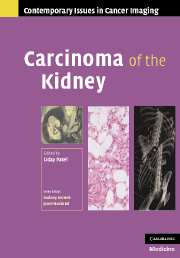Book contents
- Frontmatter
- Contents
- Contributors
- Series foreword
- Preface to Carcinoma of the Kidney
- 1 Renal cell cancer: overview and immunochemotherapy
- 2 Pathology of adult renal parenchymal cancers
- 3 Familial and inherited renal cancers
- 4 Radiological diagnosis of renal cancer
- 5 Staging of renal cancer
- 6 The case for biopsy in the modern management of renal cancer
- 7 Imaging characteristics of unusual renal cancers
- 8 Surgery for renal cancer: current status
- 9 Ablation of renal cancer
- 10 Post-treatment surveillance of renal cancer
- 11 Imaging for nephron-sparing procedures
- Index
- Plate Section
- References
3 - Familial and inherited renal cancers
Published online by Cambridge University Press: 08 August 2009
- Frontmatter
- Contents
- Contributors
- Series foreword
- Preface to Carcinoma of the Kidney
- 1 Renal cell cancer: overview and immunochemotherapy
- 2 Pathology of adult renal parenchymal cancers
- 3 Familial and inherited renal cancers
- 4 Radiological diagnosis of renal cancer
- 5 Staging of renal cancer
- 6 The case for biopsy in the modern management of renal cancer
- 7 Imaging characteristics of unusual renal cancers
- 8 Surgery for renal cancer: current status
- 9 Ablation of renal cancer
- 10 Post-treatment surveillance of renal cancer
- 11 Imaging for nephron-sparing procedures
- Index
- Plate Section
- References
Summary
Introduction
Although familial and inherited renal cancers account for only 1%–4% of all renal tumors, they have had a disproportionate impact on our understanding of renal cancer biology. Unlike sporadic renal cancer, hereditary forms tend to be multiple, bilateral, develop earlier in life, and occur with similar frequency between the sexes. The discovery of the von Hippel–Lindau (VHL) tumor suppressor gene in 1993 was the first definitive genetic evidence for hereditary renal cancer and it has subsequently been shown to be important in the formation of sporadic clear cell carcinomas of the kidney. The advance of genomics over the last 15 years has led to the discovery of a number of new genes and new inherited renal cancer syndromes. Inheritable diseases with an increased risk of developing renal cancer in adults include VHL (von Hippel–Lindau), BHD (Birt–Hogg–Dubé), HPRC (hereditary papillary renal carcinoma), HLRCC (hereditary leiomyomatosis renal cell cancer), TS (tuberous sclerosis), and FRO (familial renal oncocytoma). The proportion of renal tumors attributed to inherited disease may well increase as the understanding of these syndromes improves. Knowledge of these syndromes is of practical importance to the radiologist, who may be the first to suggest a hereditary basis on typical imaging findings.
The diagnosis of a genetic predisposition to cancer can lead to screening of close family members, the early detection of cancer in these individuals, and earlier, potentially more successful, treatment.
- Type
- Chapter
- Information
- Carcinoma of the Kidney , pp. 38 - 63Publisher: Cambridge University PressPrint publication year: 2007



